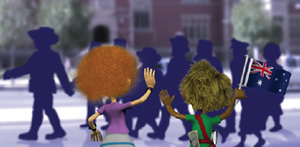
Anzac Day occurs on 25 April every year. On this day we remember and honour all Australians who have served in wars, conflicts and peacekeeping operations around the world, including the ANZACs (Australian and New Zealand Army Corps) who fought at Gallipoli in Turkey during World War I. Incredibly, more than 100 years have passed since Australia’s involvement in the First World War.
World War I
World War I was a defining period in Australian history. Taking place only 13 years after the federation of Australia, it was one of the first major international conflicts in which our young nation had been involved.
World War I began in August 1914 when Britain and Germany declared war on each other. In the same year, Australia followed Britain into war when both the Prime Minister Joseph Cook, and the Opposition Leader Andrew Fisher, declared Australia’s support for Britain. At that time 416,809 men enlisted to fight for Australia. Of these men, over 60,000 were killed and 152,000 were injured. One of the most significant events of World War I for Australians was the ANZAC landing at Gallipoli in Turkey.
Gallipoli
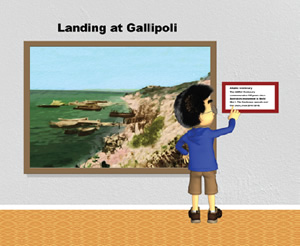
Of all the events in Australia’s history, the battle at Gallipoli in World War I stands out as having defined the spirit of our nation.
Although Gallipoli represents different things to different people, the story of the ANZACs who fought at Gallipoli is one of perseverance and courage in the face of failure and despair.
After four months of training in Egypt, the ANZAC troops left for Gallipoli. At dawn on 25 April 1915 they landed at a beach now known as ANZAC Cove. The landing was nightmarish; the beach was at the bottom of a steep slope, meaning that the ANZACs had a tough and dangerous struggle to climb up the beach as the well-organised Turkish troops rained shells and gunfire down onto them from the top of the cliff.
Here is the failure and the legend of the ANZACs: they had landed in the wrong position. They had meant to land on a flat beach where they would have had a better chance of reaching the shore to attack enemy troops.
Instead, the ANZACs and the Turkish troops reached a deadlock, with neither able to take any new ground for months. The ANZACs began evacuating on 20 December 1915. The Australians had spent only eight months in Gallipoli, but in this short time had suffered 25,000 casualties, including 8700 deaths.
The bravery and endurance of Australian troops in the face of death is what turned this horrific event into a legend that has helped to shape our country.
The Battle of Fromelles

The Battle of Fromelles was fought between Australian and German troops in France during World War I. It was the first battle involving Australians on the Western Front. The battle began at 6pm on 19 July 1916 and ended the next morning (20 July) at 8am. During this short period, the Australians suffered around 7000 casualties (including 2400 killed) compared to the 1600 German casualties. Although the remains of many Australians were recovered from the battlefield, many were left unaccounted for, even after the war had ended.
Ninety years later, a Melbourne school teacher and amateur historian named Lambis Englezos began compiling evidence to prove that the remains of hundreds of Australian and British troops lay in mass unmarked graves behind the German line at Fromelles. Englezos’ research was so compelling that, in 2008, an official investigation was launched. The Oxford Archaeology team set to work recovering the remains of 250 Australian and British soldiers. DNA testing is being used to identify the soldiers and is helping to bring peace to the families of those who remained missing for so long.
The fallen soldiers have been laid to rest with full military honours at the new Fromelles (Pheasant Wood) Military Cemetery in France.
The Somme Offensive
One of the reasons for the Battle of Fromelles was to draw German troops away from the Somme offensive, which was taking place in a region of France called the Somme Valley. The Somme Valley was the backdrop to many of the bloodiest conflicts and terrible conditions in 1916 and 1917.
During the first day of the offensive, 1 July 1916, the British army had 60,000 casualties, with nearly a third of those dead. For Britain, this campaign was terribly costly, and destroyed their volunteer army, meaning that they had to rely on conscription to replenish the army.
The Somme offensive heavily affected the number of Australian troops, as volunteer numbers decreased when people back home realised the true tragedies of war. In 1916, Prime Minister Billy Hughes called for a referendum (a majority rules by the people of Australia) to decide whether conscription should be introduced in Australia or not. The Nation said ‘No’, however, in 1917, Hughes called for another referendum, where again, Australia’s response was ‘No’.
The ANZAC Spirit
To cope with the tragic losses our country saw at Gallipoli, the men and women of Australia searched for the positive in the experience. To get through such a horrendous time the soldiers had to develop strong bonds with each other and demonstrate extraordinary courage, endurance and bravery.
So, today, when you hear someone speak about the ANZAC spirit, think of courage, bravery, endurance, mateship, determination and sacrifice. These are the values that were demonstrated so strongly by the soldiers at Gallipoli and are important in defining Australia as a nation.
Simpson and his donkey
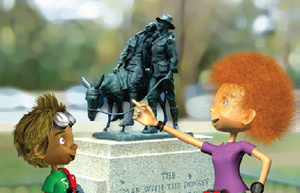
One man who exemplified the ANZAC spirit was Private John Simpson Kirkpatrick. Simpson, as he was known, was a stretcher-bearer in the Australian Army Medical Corps. Night or day, he rescued injured men from the battle line at Monash Valley and transported them to safety at ANZAC Cove on the back of his donkey. The donkey had originally been brought to Gallipoli for carrying water but, with Simpson, it found a much greater cause. In only 24 days at Gallipoli, Simpson and his donkey rescued around 300 wounded soldiers.
Honouring the ANZACs
In 1916, one year after the Gallipoli landing, 25 April was officially declared as Anzac Day. In the beginning, Anzac Day honoured the ANZACs. However, after World War II, Anzac Day came to be about honouring all veterans, servicemen and women, alive or dead. Anzac Day commemorates everyone who has been involved in wars, conflicts and peacekeeping operations, from the Occupation of Japan, to the Korean War, to the Vietnam War, to the conflict in Afghanistan.
Over the years, many Anzac Day traditions have formed. Since 1927, Anzac Day has begun with a Dawn Service. Dawn is a symbolic time. The landing at Gallipoli occurred at dawn, and soldiers are customarily woken before dawn and called to ‘stand-to’ (meaning to man their positions).
Dawn Services generally incorporate the following elements: veterans are called to ‘stand-to’, followed by one or two minutes of silence to remember the fallen, then the silence is broken by a single bugle (a brass horn instrument) playing the Last Post. The Last Post was originally played during war to tell soldiers the day was over. When the Last Post is played at memorial services it symbolises that the duty of the dead is over and that they are able to rest in peace. Today, services often include the reading of hymns and poems, a gun salute and Reveille (the bugle call to wake up).
Anzac Day parades are also held, with ex-servicemen and women marching in uniform. Flowers and wreaths are laid on graves or memorials. A poppy or sprig of rosemary is worn on Anzac Day. Rosemary is for remembrance and poppies symbolise the bloodshed in war. During World War I, red poppies were the first plants to grow on the devastated French and Belgian battlefields. Soldiers used to say that their red colour came from all the blood spilt on the ground. On Anzac Day, flags are lowered to half-mast as a sign of honour, respect and mourning.
Some Australians choose to travel to Gallipoli in Turkey for an Anzac Day service by the beach. Others travel to France for the services at Villers-Bretonneux and Bullecourt.
Harefield Park – England
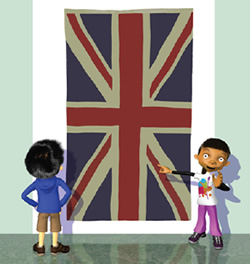
A man who certainly demonstrated the ANZAC spirit was a wealthy Australian named Charles Billyard-Leake who, in 1914, was living at Harefield Park: a large manor house in Middlesex, England. Charles was too old to join the army in 1914 (when World War I began), but he still wanted to support the war effort of his birth country. He did this by allowing his house and its large, sprawling grounds to be used as a hospital for ANZAC soldiers. Throughout the war, and for six months after it finished, 50,000 ANZACs stayed at Harefield Hospital. The King and Queen of England also paid a visit in 1915.
Today the students from a local primary school, Harefield Junior School, are keeping this time in history alive by studying the stories of Australian soldiers who stayed at Harefield Hospital. The local village holds an Anzac Day celebration every year, where children parade through the town before laying wreaths or flowers on some of the 111 graves of Australian soldiers and one nurse.
A flag from Harefield School was used to cover the coffins of the soldiers who died at Harefield Hospital. This flag now hangs in Adelaide High School in South Australia, as a sign of their shared history. During World War I, the Adelaide High School community sent parcels of food and money donations to every student and teacher at Harefield School. The two communities still keep in contact today.
It’s not all about history
Anzac Day is not all about history. Even though Australia is not at war, many Australians are currently serving in wars and peacekeeping operations overseas. Anzac Day is a particularly important date to Australians with friends or family members in the Australian Defence Force (ADF). On Anzac Day, many families think of their mothers, fathers, sons, daughters, brothers or sisters who are in war zones or on peacekeeping missions overseas.
There are currently thousands of ADF personnel based around the world. In many locations, Australians are working with other nations such as New Zealand, France, Canada and the USA to maintain peace and stability. Peacekeeping is a major role of the ADF.
Some of the tasks performed by ADF personnel can be as simple as providing dental and medical care to locals, or veterinary assistance to livestock on farms. These acts, although seemingly simple, can change people’s lives.
Anzac Day fast facts
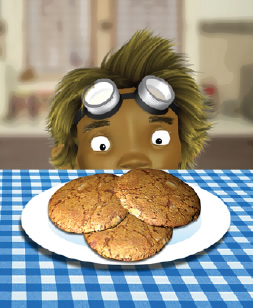
- The ANZAC Centenary was commemorated from 2014 to 2018, with services and events across the country and around the world. On 25 April 2015 (exactly 100 years since the original landing at Gallipoli) the traditional Dawn Service at Gallipoli in Turkey was attended by more than 8,000 Australians, 2,000 New Zealanders and 500 official representatives from other Nations, forming a 10,500 strong crowd.
- The mothers, sisters and wives left behind during World War I sent Anzac biscuits made of oats, sugar, flour, coconut, butter and golden syrup to their sons, brothers and husbands at Gallipoli. Anzac biscuits were hard and long-lasting, designed to survive the long journey to the troops. Some men crushed them, mixed them with water and ate them like porridge.
- The last surviving ANZAC, Alec Campbell, died on 16 May 2002.
- World War I was often referred to as the ‘Great War’.
- In World War I, Australians not only served at Gallipoli but also on the Western Front (France and Belgium) as well as in the Middle East.
- The Australian Imperial Force (AIF), the Royal Australian Navy (RAN), the Australian Light Horse and the Australian Flying Corps all fought in World War I.
- The word ANZAC has been protected by Australian legislation since 1921. This ensures that the word is not misused. To use the word you must seek permission from the Minister for Veterans’ Affairs.
- Although women were not allowed to fight in World War I, many tended to the injured troops overseas and in Australia as members of the Australian Army Nursing Service.
- Simpson’s donkey was most often called Duffy, but was also called Abdul or Murphy.
- Two decades after the end of World War I, Australia once again followed Britain into war for World War II.
References
- Gallipoli and the Anzacs: anzacportal.dva.gov.au
- Australian War Memorial: www.awm.gov.au
- Australian Government Department of Veterans’ Affairs: www.dva.gov.au
- Ergo: ergo.slv.vic.gov.au
- Adelaide High School: www.adelaidehs.sa.edu.au
- Royal Australian Air Force: www.airforce.gov.au




